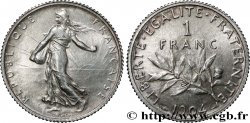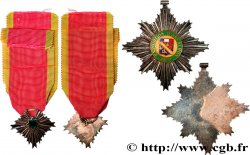E-auction 571-516065 - fme_505498 - III REPUBLIC Médaille, Exposition internationale du Nord de la France
You must signin and be an approved bidder to bid, LOGIN TO BID. Accounts are subject to approval and the approval process takes place within 48 hours. Do not wait until the day a sale closes to register. Clicking on « bid » constitutes acceptance of the terms of use of cgb.fr private e-auctions.
Bids must be placed in whole Euro amounts only. The sale will start closing at the time stated on the item description; any bids received at the site after the closing time will not be executed. Transmission times may vary and bids could be rejected if you wait until the last second. For further information ckeck the E-auctions F.A.Q.
NO BUYER'S FEE.
NO BUYER'S FEE.
| Estimate : | 100 € |
| Price : | 29 € |
| Maximum bid : | 35 € |
| End of the sale : | 25 March 2024 20:21:20 |
| bidders : | 5 bidders |
Type : Médaille, Exposition internationale du Nord de la France
Date: 1911
Mint name / Town : 59 - Roubaix
Metal : bronze
Diameter : 53,5 mm
Orientation dies : 12 h.
Engraver LEFEBVRE Hippolyte (1863-1935)
Weight : 48,78 g.
Edge : lisse + losange BRONZE
Puncheon : BRONZE
Coments on the condition:
Patine hétérogène légèrement irisée. Petite usure
Obverse
Obverse legend : 1ER NRE * 1469 // PIERRE / DE / ROUBAIX DONNANT AUX HABITANTS / DE SA VILLE LA CHARTE QUI LES AUTORISE / A FAIRE DRAPS DE TOUTES LAINES.
Obverse description : Scène médiévale dans un cartouche aux armes de la ville et inscrit en six lignes. Signé : HIPPOLYTE LEFEVRE.
Reverse
Reverse legend : EXPOSITION INTERNATIONALE / DU NORD DE LA FRANCE.
Reverse description : Allégorie de Roubaix assise sur un aigle et portant un caducée, avec un écu inscrit Roubaix 1911. Signé : HIPPOLYTE LEFEVRE.
Commentary
Exemplaire non décerné. Dimensions : 53.5*38.5 mm.
Hippolyte Lefèbvre, né le 4 février 1863 à Lille, mort en novembre 1935 à Arcueil, est un sculpteur et médailleur français. Issu d'un milieu ouvrier, Hippolyte Lefèbvre suit des études artistiques à l'école des beaux-arts de Lille où il obtient des prix et une bourse d'étude pour l'École des beaux-arts de Paris où, en 1882, il devient l'élève de Jules Cavelier, Louis-Ernest Barrias et Jules Coutan. Il expose régulièrement au Salon des artistes français dès 1887 et, après avoir obtenu le second prix en 1888 et 1891, il reçoit le grand prix de Rome de 1892 en sculpture pour sa statue Adam chassé du Paradis est condamné à travailler la terre, à la sueur de son front. De retour à Paris après son séjour romain à la villa Médicis, il obtient une médaille d'or à l'Exposition universelle de 1900, et poursuit avec succès une carrière de sculpteur bénéficiant de commandes de l'État français.
Pierre, seigneur de Roubaix est né à Herzele (près de Bruxelles) le 1er août 1415. Il décède à Roubaix le 7 juin 1498 et est inhumé en l'église paroissiale Saint-Martin, dans la chapelle "Sainte-Croix". Il succède le 7 juin 1449 à son père, Jean V de Roubaix. Il a trente quatre ans. Très jeune, il avait épousé Marguerite de Ghistelle, dame du Broeucq et de Wasquehal, héritière de l'une des plus nobles et des plus anciennes maisons de Flandres.
Il fit passer la ville d'une petite localité à une des villes les plus prospères de la région, notamment en obtenant le 1er octobre 1469 une charte de l’État bourguignon lui garantissant un privilège d'exercer le commerce et la manufacture. Il accumula par ce biais une considérable fortune.
Pierre de Roubaix fut aussi un grand voyageur, qui se rendit à Rome, à Jérusalem, alla combattre les infidèles à Carthage, etc.
À sa mort, il n'avait qu'une fille, Isabeau de Roubaix, qui lui succéda. Après lui, la branche masculine ainée de la famille "de Roubaix" s'éteint et la domination du fief passe, par le mariage d'Isabeau avec Jacques de Luxembourg et par le mariage de leur fille ainée Isabelle de Luxembourg à Jean III de Melun, à la maison de Melun. La descendante de Jean III, Jeanne de Melun, portait le titre de Marquise transmis à la maison de Ligne par son mariage avec Lamoral Ier, premier prince de Ligne, et actuellement la famille Meurillon..
Hippolyte Lefèbvre, né le 4 février 1863 à Lille, mort en novembre 1935 à Arcueil, est un sculpteur et médailleur français. Issu d'un milieu ouvrier, Hippolyte Lefèbvre suit des études artistiques à l'école des beaux-arts de Lille où il obtient des prix et une bourse d'étude pour l'École des beaux-arts de Paris où, en 1882, il devient l'élève de Jules Cavelier, Louis-Ernest Barrias et Jules Coutan. Il expose régulièrement au Salon des artistes français dès 1887 et, après avoir obtenu le second prix en 1888 et 1891, il reçoit le grand prix de Rome de 1892 en sculpture pour sa statue Adam chassé du Paradis est condamné à travailler la terre, à la sueur de son front. De retour à Paris après son séjour romain à la villa Médicis, il obtient une médaille d'or à l'Exposition universelle de 1900, et poursuit avec succès une carrière de sculpteur bénéficiant de commandes de l'État français.
Pierre, seigneur de Roubaix est né à Herzele (près de Bruxelles) le 1er août 1415. Il décède à Roubaix le 7 juin 1498 et est inhumé en l'église paroissiale Saint-Martin, dans la chapelle "Sainte-Croix". Il succède le 7 juin 1449 à son père, Jean V de Roubaix. Il a trente quatre ans. Très jeune, il avait épousé Marguerite de Ghistelle, dame du Broeucq et de Wasquehal, héritière de l'une des plus nobles et des plus anciennes maisons de Flandres.
Il fit passer la ville d'une petite localité à une des villes les plus prospères de la région, notamment en obtenant le 1er octobre 1469 une charte de l’État bourguignon lui garantissant un privilège d'exercer le commerce et la manufacture. Il accumula par ce biais une considérable fortune.
Pierre de Roubaix fut aussi un grand voyageur, qui se rendit à Rome, à Jérusalem, alla combattre les infidèles à Carthage, etc.
À sa mort, il n'avait qu'une fille, Isabeau de Roubaix, qui lui succéda. Après lui, la branche masculine ainée de la famille "de Roubaix" s'éteint et la domination du fief passe, par le mariage d'Isabeau avec Jacques de Luxembourg et par le mariage de leur fille ainée Isabelle de Luxembourg à Jean III de Melun, à la maison de Melun. La descendante de Jean III, Jeanne de Melun, portait le titre de Marquise transmis à la maison de Ligne par son mariage avec Lamoral Ier, premier prince de Ligne, et actuellement la famille Meurillon..








 Report a mistake
Report a mistake Print the page
Print the page Share my selection
Share my selection Ask a question
Ask a question Consign / sell
Consign / sell
 Full data
Full data



